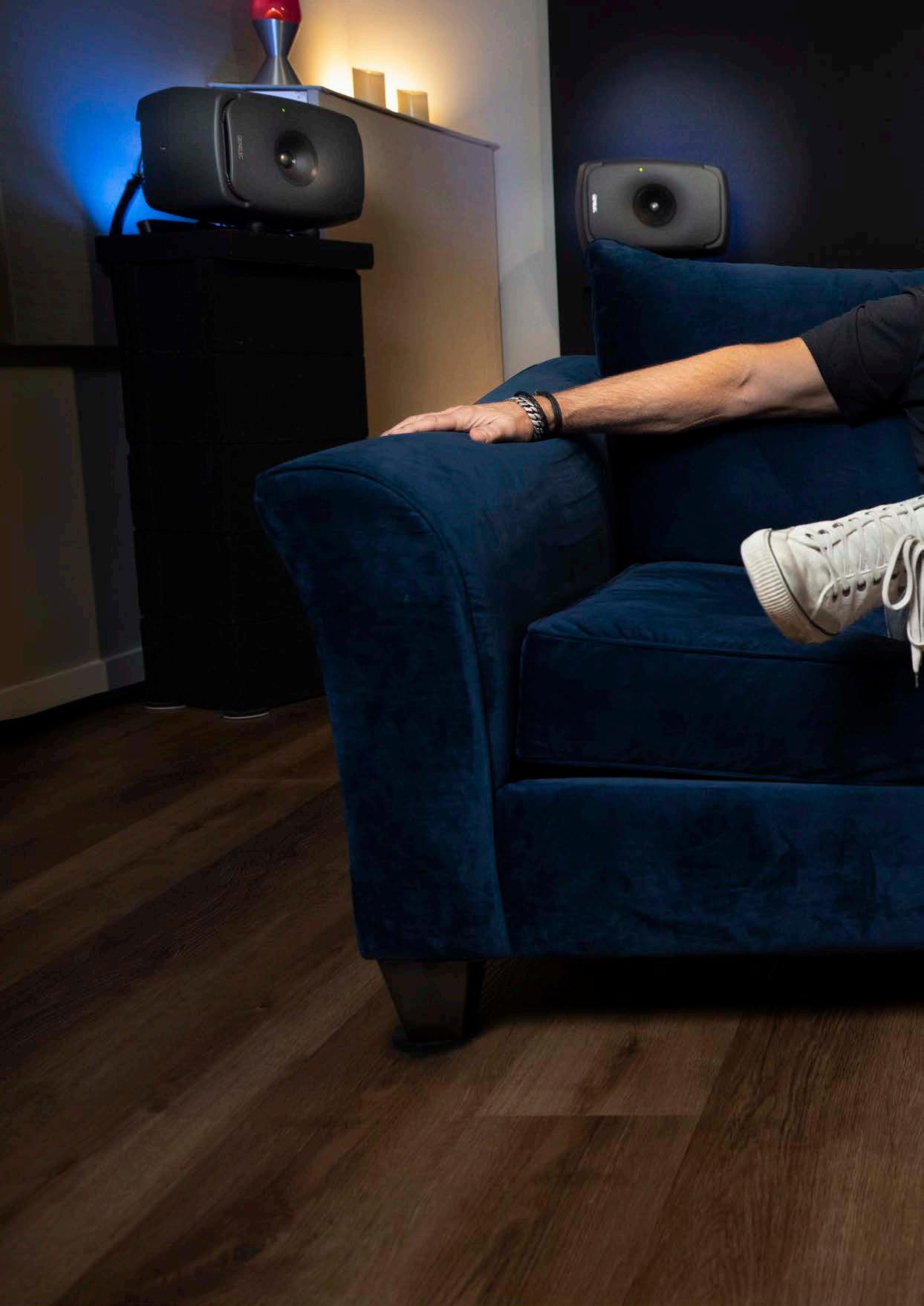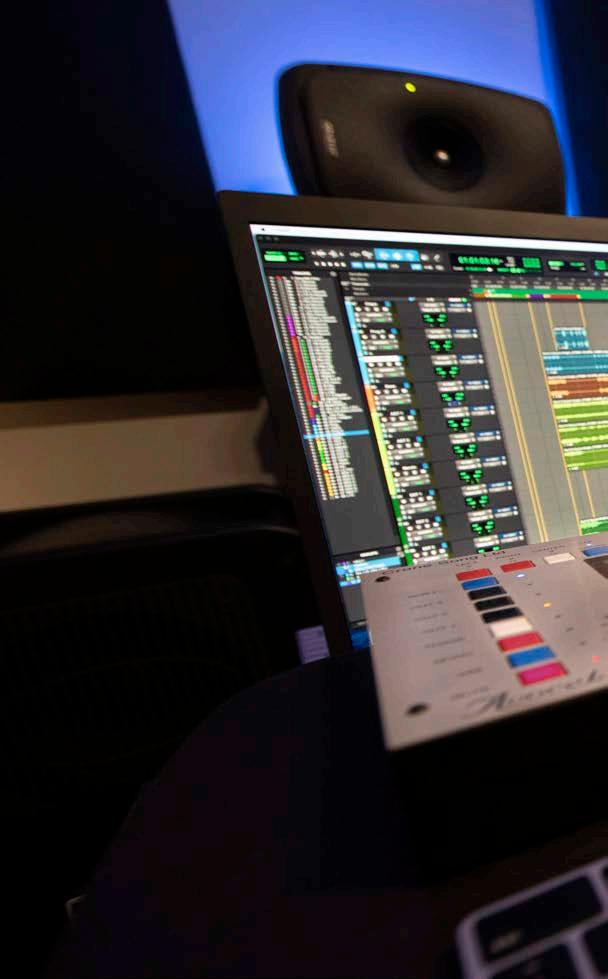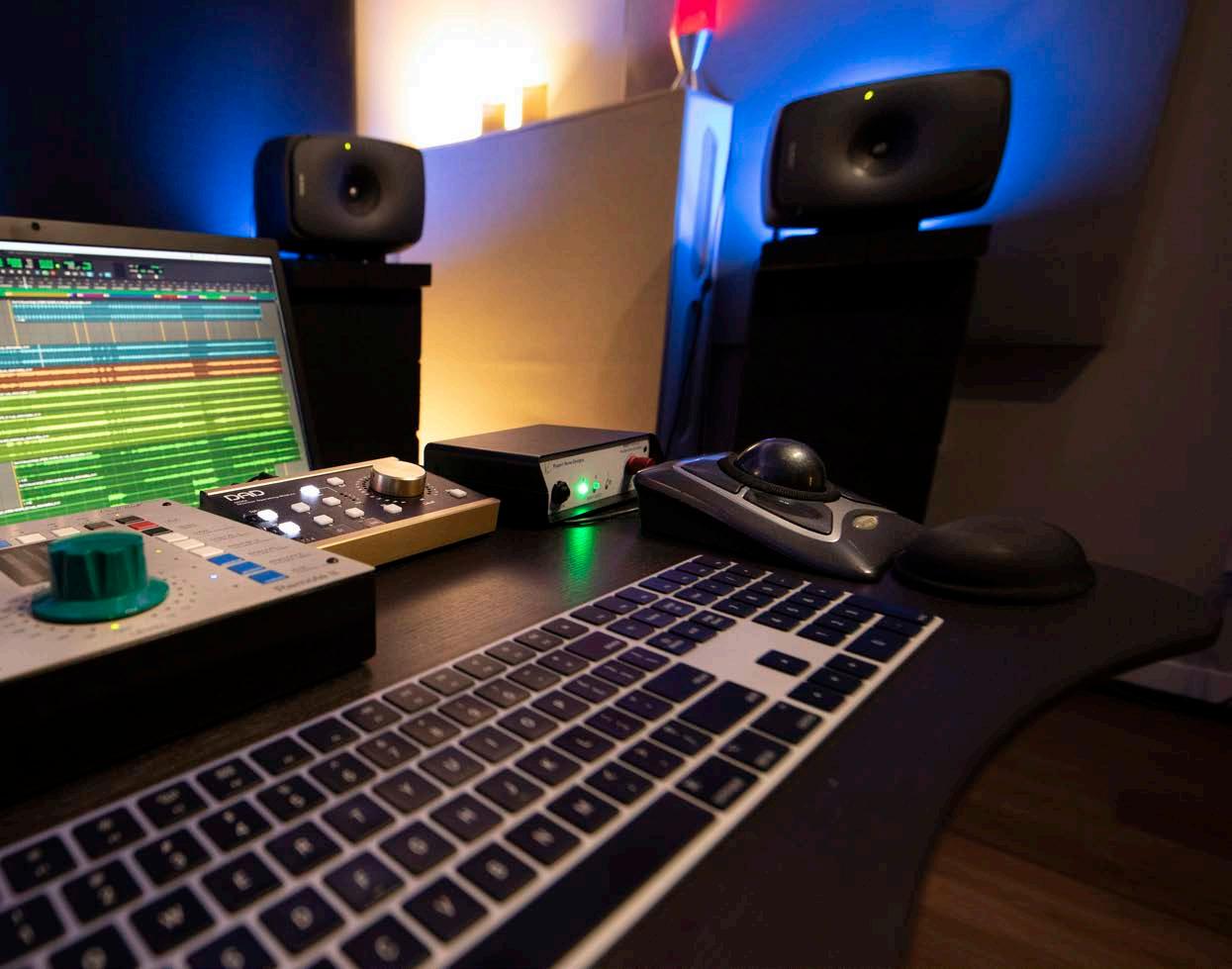
10 minute read
COVER FEATURE: JEFF BALDING
LEADING WITH
INTEGRITY

A new studio and 800 mixes in, Nashville producer/engineer Jeff Balding is setting the bar for immersive production— and it’s about so much more than the music.
All photos: credit CJ Hicks
Producer/engineer Jeff Balding has always envisioned soundscapes in three dimensions. So when the six-time Grammy nominee, known for his work with iconic artists like Dan+Shay, Taylor Swift,
Carrie Underwood, Morgan Wallen, Shania Twain,
The Eagles and Megadeth, started getting requests for immersive mixes, he dove in and never looked back.
In 2021, Balding opened Imogen Sound in the heart of Nashville’s Berry Hill, where he focuses almost entirely on immersive mixing, both new releases and re-issues, in Dolby Atmos and Sony
Reality Audio 360.
We chatted with Balding about launching his immersive mixing business, advocating for better studio workflows and practices, and how immersive music has the potential to forge deeper connections between fans and the songs they love.
AMI: When did you know the time was right to launch Imogen Sound?
Early in summer 2021, when Apple announced they were going to support immersive with Spatial Audio, the labels and everybody signed on. The reason I thought it was going to stick was, all of a sudden there’s an outlet for all consumers to get immersive content. Whether they knew they were getting it or not, there was an outlet, and there were a lot of big players involved, so it was like, “Okay, if this fails, it’s going to fail big.” But, I thought, “I’m in, I love the idea, I love the format.” Although I had already been doing immersive mixes, that was the real tipping point for me to put in the immersive room and focus on mixing. I had to move pretty quickly because calls were coming in.
AMI: It was like the Wild West; everything was moving so fast.
It was like the Wild West. My first panic was, “Well, I’m going to need a room big enough to accommodate all of the speakers needed for immersive mixing.” Then it was a matter of post-pandemic supply chain issues, trying to get speakers, speaker stands, everything I needed. Luckily I was able to get Genelec onboard and get some speakers in quickly, but the speaker stands were another issue. I ended up going to Home Depot and getting concrete blocks and painting them, and honestly they are probably some of the best-sounding speaker stands you can have, because they’re really solid.
AMI: You have a 9.1.4 system based on Genelec 8351Bs; you’ve used Genelecs for a long time, right?
Yeah, for years I used Genelec 1031s, as well as my Tannoy SGM10s with the Mastering Lab crossovers, for tracking and mixing. One of the selling points of the new Genelecs was being able to manage and tune the speakers with Genelec’s GLM software. My studio is set up with both a Sony 360RA speaker layout and a Dolby Atmos speaker layout, so I’m able to go between GLM profiles to easily switch between formats. It was challenging to figure out how to have both speaker setups in the room and manage them, but I’m happy with the end result.

AMI: You must have to have really efficient workflows to do the amount of immersive work you’re doing.
I’ve spent a lot of time tweaking the workflow. It’s a little bit like a mastering house workflow where you have different people taking responsibility for different aspects of the process. This style of workflow covers all the bases and guarantees delivering a consistent, high-quality product to the client.
AMI: Has QCing become more complex with immersive projects?
Yes, the deliverable is more complex so there’s a lot more to the QC process on both the front end and back end. Also, sonic artifacts become more obvious in an immersive mix because of the sonic landscape. So the QC on the front end involves everything from

removing noises like ticks and pops as well as making sure we have all the right parts, the right instruments and the right takes. A lot of times with the released stereo mix, mastering will clean up noises like ticks or pops. We have to go through each song and take them out before I mix, mainly because they’re so obvious in an immersive format.
On one project there was one song I mixed that had vinyl scratches going through the song on the multitrack, but I noticed I didn’t hear them in the released stereo mix. It seems mastering went in and removed all the vinyl noise from the song. It made me laugh when I figured that out. I left it in since it was part of the production decisions made by the producer for the song.
On the back-end delivery side, with Dolby Atmos in general, the ADM file is what gets delivered as the final mix. But there are a lot more aspects to delivery,
Immersive Mini Playlist
We asked Balding to share a couple of his favorite immersive tracks; these mixes are best experienced on a component speaker system.
Blake Shelton Boys Around Here
Dolby Atmos mix available on TIDAL, Apple Music, Amazon Music Unlimited
Listen for: panning placement and movement of background vocal hooks, sweeps, and uplifters; and for movement across the top of the soundstage
For KING & COUNTRY Relate
Dolby Atmos mix available on TIDAL, Apple Music, Amazon Music Unlimited
Listen for: dynamic scene changes, when sonic elements transition from being oriented up front to surrounding the listener

and we deliver the mix multitrack and all the appropriate metadata. We do a full deliverable because for long-term assets and archiving it’s the proper thing to do.
AMI: Let’s talk about your creative process. With your pivot to immersive, how are you thinking about things differently?
The things that you take for granted, like panning in a stereo mix, only have an effect as far as where sound is going between the two speakers. In the Dolby and Sony rendering process, panning affects the tonality of the instrument in the headphones. When you pan up high, you get more treble; the lower you pan, the fuller the sound. That all affects where you put something in the room and how it translates to headphones. You really have to be aware of those elements.
If there’s an acoustic guitar or instrument in the stereo mix that may not have been that bright, you have to watch where you pan it, or compensate for it with EQ, to make sure you’re matching the intention of the stereo mix. Another factor is both Dolby and Sony have a little bit of a room sound when going through the rendering process, which helps the headphones sound more immersive. But if you have a really intimate, dry stereo mix, it can be challenging to get the mix to have the same dry, intimate vibe in an immersive format.
AMI: We talk a lot about immersive’s expanded sound stage, but there are so many opportunities for shaping tonality...
Well, it’s definitely a bigger palette, no doubt. You have a lot more sonic space to play with. The trick with the expanded sonic space is, is the song connecting with the listener? For me it’s the song first, and then, is the approach I’m taking effective? Is the listener having a great experience and a connection to the song? I believe you can give a listener a deeper experience in an immersive format because it gives you additional space to draw the listener into, if it’s used effectively.
AMI: How do you walk the line when you’re re-imagining beloved, familiar recordings?
I do a lot of new releases, but the projects that’ve been previously released is always a challenge. Especially in headphones. If the listener is not aware that they’re hearing an immersive mix—it just happened to turn on because it’s the default setting on their phone—are they going to think, “Well, this doesn’t sound like I remember the song sounding”? There’s a bit of that matching the stereo mix that’s really crucial as far as listener experience. But at the same time, lay it out in a way that gives somebody a new experience, gives them something that helps them connect on a new level to their favorite song.

The other thing to think about with immersive mixing is translation of the mix moving forward toward the future. You can mix for headphones right now because that’s the majority of the listeners experiences, but what happens when more auto manufacturers come out with immersive systems in their cars? Then more people will be hearing the mix in speakers, in the car. So you have to plan for the future by making sure the mix translates both in speakers and headphones.
AMI: Do you think having easy access to immersive music will encourage fans to listen more actively?
Absolutely. Obviously it depends on having a great immersive mix, so they have a new listening experience with the music. As immersive has become a more viable and solid format, I’m finding clients are becoming more particular with the mix and more interested in the details of the mix. And that’s a good thing.
Documenting the Details: Delivery Best Practices
In 2023, the Recording Academy will release its updated Recommendations for the Delivery of Recorded Music Projects, which outlines best practices for organizing and managing files throughout creation, delivery and archival and covers everything from file naming to project folder hierarchies to metadata checklists. Jeff Balding co-chairs the committee authoring the document.
AMI: You’ve helped shape this evolving set of guidelines for two decades. Why has it been so important for you to advocate for these best practices?
Personally, I always believe it's important to give back to the industry. And as creators, I believe it’s critical that we advocate for the preservation of the music we make for future generations, and that takes best practices to accomplish that.
The committee brings their experiences into the room; I refer to it as our “wisdom,” meaning making a lot of mistakes and learning what works best in a workflow, through those mistakes. It’s about bringing that to the table so others can take that guidance and build off of it.
AMI: There are a million different ways to arrive at a mix or a record. Why standardize practices?
It’s really about best practices. Deliverables are more about a consistent delivery process for project assets in order to preserve the music for the future.
In the beginning what started the delivery recommendations project was one of the label administrators came to us and said, "I have a data DVD, and there's no writing on it. What is this? Is this the project that I paid $200,000 for?" And this was happening across several of the labels.
AMI: In outlining these recommendations, how do you walk the line between establishing best practices and informing someone's workflow or creativity?
The committee in general is very conscious of that—to the point where if we make a workflow suggestion, we suggest it be used as a building block to start from, because sometimes, like in writing, a blank page is the hardest thing to deal with. If you have a starting point you can say, "Okay, I understand what they're saying. I can customize that and adapt it to fit my workflow." But you have to be very careful: People use a lot of creative methods, but when it comes to documentation and archival, some methods are prone to failure and some are reliable.
And that's what we base our recommendations on, to provide a baseline that people can apply to their own creative workflows.
Download Recording Academy technical guidelines at www.recordingacademy.com











